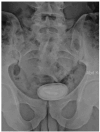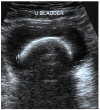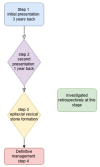Pearl in a seashell: epitaxy of solitary cystolith on the leftover curl of a double j stent - a case report
- PMID: 40486589
- PMCID: PMC12140664
- DOI: 10.1097/MS9.0000000000003248
Pearl in a seashell: epitaxy of solitary cystolith on the leftover curl of a double j stent - a case report
Abstract
Introduction and importance: Epitaxy is a process of stone formation in an intricate pattern of layers over a nidus. This case report highlights rare phenomenon of cystolith formation through epitaxy on a leftover curl of double j stent (DJ stent), emphasizing the importance of careful post-removal assessment and management to prevent complications.
Case presentation: A 30-year-old male presented with dysuria and intermittent urination for 1 month. He had a history of ureterolithotripsy and DJ stent insertion 3 years ago, with a difficult stent removal a year prior. Examination revealed suprapubic tenderness, and lab tests showed normal blood count and renal function, with some red and white blood cells in urine. Imaging revealed a >5 cm bladder stone associated with a leftover DJ stent curl. After stabilizing the patient, cystolithotomy was performed, removing large stone, and stent curl. The stent curl likely served as the core for stone formation. The patient recovered well during follow-up visits.
Clinical discussion: Ureteral stents, developed over a century ago, are widely used in urology, particularly after upper tract stone procedures. However, prolonged use of DJ stent can lead to complications, including encrustation, breakage, and stone formation, especially calcium phosphate stones. There are many conditions that lead to stone formation on DJ stents like urinary tract infections, metabolic disorders, recurrent stone disease, and prolonged indwelling time of stent inside the urinary system.
Conclusion: Careful monitoring and management of foreign bodies in the bladder are crucial to prevent vesical stone formation. Timely removal of DJ stents is essential to avoid encrustations and ensure complete elimination, preventing future nidus-related stones. Proper handling of impacted DJ stents is vital during treatment.
Keywords: cystolithotomy; double j stent; epitaxy; foreign body; vesical stone.
Copyright © 2025 The Author(s). Published by Wolters Kluwer Health, Inc.
Conflict of interest statement
Sponsorships or competing interests that may be relevant to content are disclosed at the end of this article. The authors declare no conflict of interest.
Figures






References
Publication types
LinkOut - more resources
Full Text Sources
Miscellaneous
